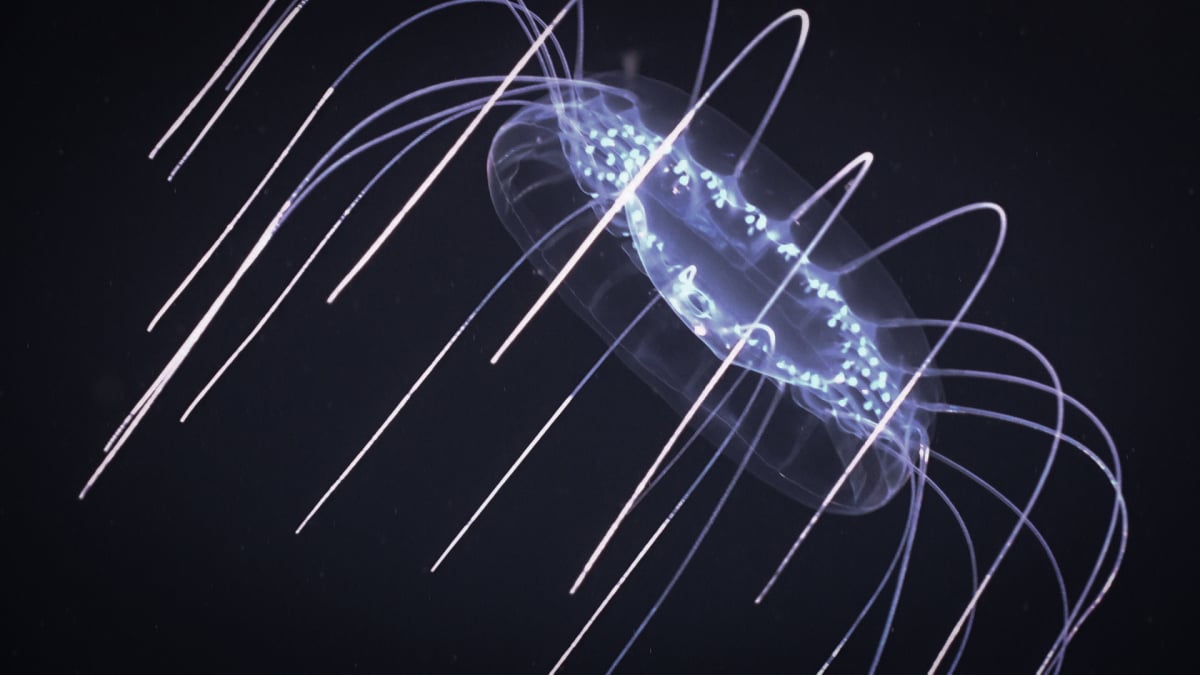Entertainment
The deep sea discoveries and sightings of 2022 are fascinating

An age of discovery is upon us.
Big vessels, carrying robust robotic explorers and sometimes submersibles piloted by humans, embark on deep sea expeditions each year. This lightless realm remains a largely mysterious place, and just around 25 percent of the seafloor is decently mapped. Deep ocean missions are often considered the new exploration of little-known — or just never-visited — places on Earth.
Down there, it’s common for something to baffle scientists. On the National Oceanic and Atmospheric Administration’s (NOAA) six-month Voyage to the Ridge 2022, biologists spotted a curious, living “blue goo” on the Caribbean seafloor, at some 1,400 feet down. Might it be an unusual new-to-science sponge? Or something else entirely?
“We didn’t know what it was,” Derek Sowers, an expedition lead for NOAA Ocean Exploration, told Mashable. “We always discover stuff when we go out into the deep sea. You’re always finding things that you haven’t seen before.”
That’s why deep sea exploration missions are so vital. Scientists want to shine a light — literally and figuratively — on what’s down there. The implications of knowing are incalculable, particularly as deep sea mineral prospectors prepare to run tank-like industrial equipment across parts of the seafloor. For example, research expeditions have found that ocean life carries great potential for novel medicines. “Systematic searches for new drugs have shown that marine invertebrates produce more antibiotic, anti-cancer, and anti-inflammatory substances than any group of terrestrial organisms,” notes NOAA.
“You’re always finding things that you haven’t seen before.”
“It would be a shame to lose those possibilities without knowing what’s there first,” said Sowers. He underscored that it’s neither his nor the NOAA exploration team’s job to advocate for protecting any ocean areas — for the likes of protecting biodiversity or for benefits like future medicines — but to reveal what’s down there.
Below are some of the stunning, and at times mysterious, findings captured by different deep sea explorers in 2022.
Voyage to the Ridge

The brittlestar Ophiocreas oedipus wrapped around coral in the deep sea.
Credit: NOAA
NOAA’s 224-foot vessel Okeanos Explorer allows the agency to embark on missions of ocean exploration, with a robot capable of reaching nearly 20,000 feet down. In 2022, the mission was Voyage to the Ridge 2022, specifically the Atlantic Ocean’s Mid-Atlantic Ridge (as well as other areas in the Caribbean). It’s the longest mountain range on Earth, and at the meeting of two giant tectonic plates, it’s an area that’s spreading apart, allowing new rock to rise from under the seafloor. And because this is all happening underwater in the remote Atlantic, these areas are vastly underexplored.
This voyage:
-
Captured rarely or never-before-seen footage, such as the “blue goo” organism described above, and identified around 20 new species, or species found in a new part of the ocean (rigorous species identification is underway to confirm these discoveries)
-
Explored ecosystems in an extremely dynamic part of the ocean where new seafloor is being made, and in some places, near where hot particle-rich fluid is spewing from the ground (hydrothermal vents)
-
Mapped new parts of the Mid-Atlantic region, such as the Charlie-Gibbs Fracture Zone, a giant fault running through the ridge

A transparent predatory tunicate (six inches wide) spotted on the Voyage to the Ridge 2022 expedition.
Credit: NOAA
Puzzling, unusually perfect holes on the ocean floor

An animal that burrowed horizontally through the sea floor might have made these linear holes, says a marine zoologist.
Credit: NOAA
One of the most intriguing observations on the Voyage to the Ridge 2022 expedition was the sighting of almost perfectly spaced holes on the seafloor, at some 8,000 feet beneath the surface. “The origin of the holes has scientists stumped,” NOAA tweeted. The agency explored the seafloor with a remote-operated vehicle, or ROV.
The holes might seem like the result of some sort of mechanized, human activity. But that’s unlikely. “I don’t think they’re human-made,” Mike Vecchione, a zoologist at the National Museum of Natural History who worked on and watched the dive remotely, told Mashable in August.
What might they be? As Niranjana Rajalakshmi reported for Mashable:
An animal could have burrowed through the sea floor horizontally, and occasionally pushed up holes to get fresh oxygenated water for ventilation.
A creature swam just above the surface of the sea sediment and occasionally poked something down into the sandy floor. “Sort of the way that shorebirds feed when you go to the beach. You’ll see birds walking along the edges of the surf and they’re poking their bills down into the sand every once in a while,” Vecchione explained.
You can read the full story on Mashable.
Scientists discover ancient shark swimming in a really strange place

A Greenland shark swimming in the ocean.
Credit: Dotted Yeti / Shutterstock
One of the last things biologists expected to find in the balmy Caribbean Sea was an ancient Greenland shark, a creature known for dwelling far off, in the icy Arctic.
Yet researchers, while temporarily catching and tagging tiger sharks off the coast of Belize, caught a Greenland shark (or potentially a Greenland-shark hybrid), a species that lives for centuries in the deep sea.
“It looked like something that would exist in prehistoric times.”
“We suddenly saw a very slow moving, sluggish creature under the surface of the water,” Devanshi Kasana, a biologist and Ph.D. candidate at Florida International University’s Predator Ecology and Conservation lab, told Mashable. The observation was published this year in the science journal Marine Biology. At first, the researchers thought it could be a sixgill shark, a dominant and fascinating predator of the deep sea. But they photographed the rarely-seen animal and confirmed it was a Greenland shark.
“It looked like something that would exist in prehistoric times,” Kasana added.
You can read the complete story on Mashable.
Magical, serpentine creature of the deep sea filmed by scientists
At first glance, the snaky siphonophore may look like an immensely long — upwards of 160 feet — creature.
It’s actually a giant colony of creatures.
Deep sea footage captured by the Monterey Bay Aquarium Research Institute shows a siphonophore in vivid detail. It looks somewhat like a giant, floating millipede. But it’s composed of innumerable specialized organisms doing an assortment of things.
Siphonophores dwell at some 2,300 to 3,280 feet beneath the surface, so they’re not easy to study. Marine researchers used high-resolution cameras aboard a deep sea exploration robot to focus on how the translucent bell-like pieces (“nectophores”) move the colorful colony through the water.
Scientists spot a squid doing something profoundly rare in the deep sea

A few species of squids hold their eggs until they hatch, presumably to protect them from predators.
Credit: MBARI
In July, marine researchers had a strange encounter during a dive in California’s Monterey Bay. A squid mom hauled a sprawling sheet of eggs through the water.
“During a recent deep-sea dive, MBARI researchers encountered this incredibly rare sight — a deep-sea squid (Bathyteuthis sp.) grasping hundreds of eggs in her arms,” the Monterey Bay Aquarium Research Institute (MBARI) tweeted. Their remote-operated vehicle captured this squid behavior at around 4,500 feet beneath the surface.
As Niranjana Rajalakshmi reported for Mashable:
Squids are generally thought to lay their eggs, leave them to develop on their own, and then swim away. So carrying hundreds of potential offspring is quite unusual to see.
Parental instinct gives the greatest answer for this behavior, Stephanie Bush, a marine scientist at the Smithsonian National Museum of Natural History, told Mashable. “The squid is protecting the eggs against predators,” Bush, who was not part of the dive, said. This squid could have perceived the noisy robotic vehicle as a threat, and promptly fled with the eggs when the vehicle traveled close by.
You can read the whole story on Mashable.
A deep sea lake
The deep sea exploration organization OceanX has a new, hi-tech vessel, the OceanXplorer. It carries four deep sea vehicles (two of which are submersibles that carry scientists) and a helicopter, while housing four research labs.
OceanX writes: “On its maiden mission to the Red Sea, #OceanXplorer made a surprising discovery: a brine pool, over 1,700 meters below the surface, teeming with otherworldly life — extremophiles, to be precise, lifeforms that survive in conditions we wouldn’t believe possible on our planet, and which provide clues to how life on Earth had began. This is the first ever brine pool discovered in the Gulf of Aqaba, in the northern Red Sea.” [Brine pools are bodies of water in the ocean, often with many times the salinity of the surrounding sea.]
In 2018, Mashable joined OceanX on a deep sea expedition. You can read this feature on Mashable.
An ancient ocean brawl

A graphic of a shark swimming up from the ocean depths.
Credit: Baris-Ozer / Getty Images
In the seas millions of years ago, whales were regularly hunted.
Megalodons, bus-sized sharks, are believed to have been dominant ocean predators some 20 to 3.6 million years ago. The now extinct marine legends almost certainly munched on large prey, and in 2022 scientists unearthed fascinating evidence of such a predatory event. Fossilized clues suggest a small whale was ambushed, bitten, and dramatically thrashed by this colossal shark species.
“To have been on the receiving end of a megalodon attack would have spelled almost certain doom,” Stephen Godfrey, the curator of paleontology at the Calvert Marine Museum in Maryland, told Mashable. Godfrey was an author of the new research published in the science journal Palaeontologia Electronica.
Researchers uncovered included two damaged whale vertebrae and a megalodon tooth, which provided compelling evidence of this ancient ocean encounter.
You can read the full story on Mashable.
Want more science and tech news delivered straight to your inbox? Sign up for Mashable’s Top Stories newsletter today.
Big, deep sea crawlers found

A newly identified species of deep sea isopod.
Credit: Dr. Ming-Chih Huang / Journal of Natural History
In 2022, scientists confirmed a new species large isopod, which looks similar to a roly-poly — though a giant roly-poly. These, armored 14-legged creatures inhabit the deep sea, feasting on fallen prey, like whales.
This recently confirmed species in the Gulf of Mexico, B. yucatanensis, is some 10 inches long. That’s a pretty giant deep sea scavenger, though other isopod species can grow up to a whopping 20 inches.
A popular video from 2019 shows Gulf of Mexico isopods swarming over and feasting on an alligator carcass.
Expect more stunning deep sea discoveries in the years ahead. Large vessels with advanced robotic explorers — like those used by NOAA, OceanX, the Schmidt Ocean Institute, the Monterey Bay Aquarium Research Institute, and the Woods Hole Oceanographic Institution — will continue shining bright lights on the mysteries, and fascinations, that abound below.
“The deep ocean is a treasure trove of species we know little about,” said NOAA’s Sowers.
-

 Entertainment7 days ago
Entertainment7 days agoWhat’s on the far side of the moon? Not darkness.
-

 Business6 days ago
Business6 days agoTikTok faces a ban in the US, Tesla profits drop and healthcare data leaks
-

 Business6 days ago
Business6 days agoLondon’s first defense tech hackathon brings Ukraine war closer to the city’s startups
-

 Entertainment7 days ago
Entertainment7 days agoHow to watch ‘The Idea of You’: Release date, streaming deals
-

 Entertainment6 days ago
Entertainment6 days agoMark Zuckerberg has found a new sense of style. Why?
-

 Business5 days ago
Business5 days agoHumanoid robots are learning to fall well
-

 Entertainment5 days ago
Entertainment5 days ago2024 summer TV preview: 33 TV shows to watch this summer
-

 Business4 days ago
Business4 days agoGoogle Gemini: Everything you need to know about the new generative AI platform




























